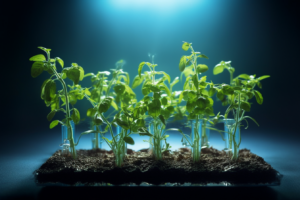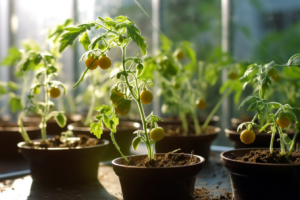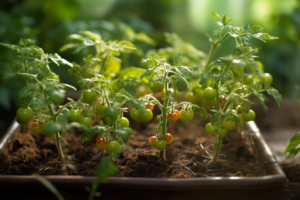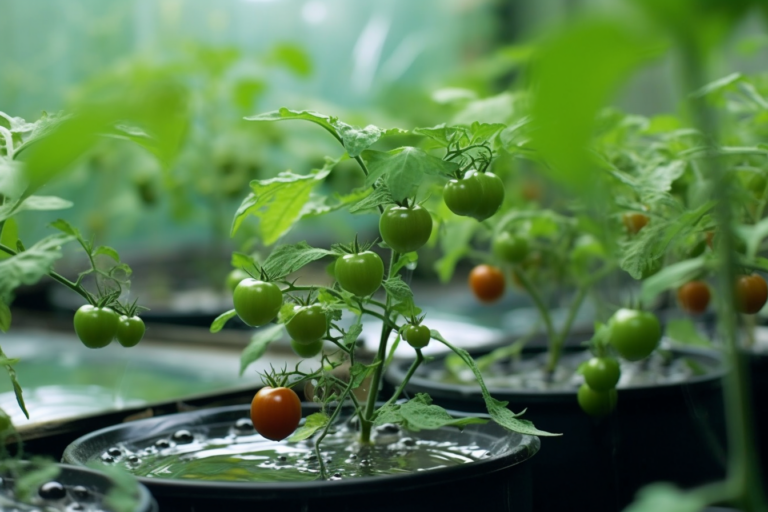Growing tomatoes is an enjoyable and rewarding process, but knowing how often to water tomato seedlings can be tricky. In this article, we will provide a detailed guide on the optimal watering schedule, as well as additional tips and tricks to ensure healthy tomato plants.
Introduction: The Importance of Proper Watering
Water is essential for tomato seedlings, as it helps in nutrient absorption, photosynthesis, and overall growth. Inadequate or excessive watering can lead to various problems such as wilt, root rot, or stunted growth. So, how often should we water tomato seedlings? Let’s dive in!
Factors Affecting Watering Frequency
There are several factors to consider when determining how often to water your tomato seedlings, including:
- Soil type
- Container size
- Climate and weather
- Plant size and stage
Soil Type
Soil type plays a significant role in determining the water retention capacity of the growing medium. Well-draining soil, such as a mix of peat, perlite, or vermiculite, is ideal for tomato seedlings. These soil types allow for proper air circulation and moisture retention without becoming waterlogged.
Container Size
The size of the container impacts the amount of water your seedlings need. Smaller containers dry out more quickly, requiring more frequent watering, while larger containers can retain moisture for a longer period.
Climate and Weather
Temperature and humidity levels affect the rate of evaporation and transpiration. In hot, dry conditions, you will need to water more frequently than in cool or humid environments.
Plant Size and Stage
As tomato seedlings grow, their water requirements change. Younger seedlings need less water, while larger plants with more foliage require more frequent watering.
The Ideal Watering Schedule
Now that we understand the factors affecting watering frequency, let’s discuss the ideal schedule for tomato seedlings.
Seedling Stage (1-3 weeks)
During the first few weeks after germination, it’s essential to keep the soil evenly moist but not saturated. Water the seedlings every 2-3 days, ensuring that the soil never dries out completely.
Transplanting Stage (3-6 weeks)
Once your seedlings have developed true leaves and are ready for transplanting, you can reduce the watering frequency to every 3-5 days. Monitor the soil moisture closely and adjust your schedule accordingly.
Established Plants (6 weeks+)
As your tomato plants grow, you’ll need to water them more frequently. Water every 2-3 days during hot, dry weather or every 3-5 days in cooler, more humid conditions.
Signs of Overwatering and Underwatering
It’s important to recognize the signs of overwatering and underwatering, as both can lead to issues with your tomato seedlings.
Overwatering
- Yellowing leaves
- Wilting despite wet soil
- Mold or fungus growth
- Root rot
Underwatering
- Dry, brittle leaves
- Wilting with dry soil
- Slow growth
- Blossom drop
Tips for Proper Watering
Here are some helpful tips for watering your tomato seedlings effectively:
- Water early in the morning or late afternoon to minimize evaporation.
- Water at the base of the plant to avoid wetting the leaves, which can lead to fungal diseases.
- Use a moisture meter or your finger to check the soil moisture before watering.
- Mulch around the base of the plants to help retain moisture and suppress weeds.
When to Water Tomato Seedlings
Proper watering is crucial for healthy tomato seedling growth. In this section, I will explain when and how to water your tomato seedlings to ensure they thrive.

Watering frequency
Tomato seedlings require moisture to germinate and grow, but it’s also important to avoid overwatering them. Watering frequency will depend on various factors such as the climate, pot size, and soil type. In general, tomato seedlings need to be watered every 3-4 days.
Watering technique
It’s essential to water tomato seedlings carefully to avoid damaging the delicate roots. You can use a watering can with a fine nozzle or a spray bottle. Ensure that the water reaches the base of the plant and doesn’t just wet the surface.
Watering in the morning
Watering tomato seedlings in the morning allows the leaves to dry out during the day and reduces the risk of fungal diseases. Besides, morning water helps your plants to withstand the high temperatures of the day as they will be well-hydrated already. Watering them at night may cause the plant to stay moist for too long, which can lead to root rot and other fungal infections.
Checking the soil moisture
Always check the soil moisture level before watering to avoid over or underwatering. Stick your finger about an inch deep into the soil, and if it feels dry, it’s time to water. It is an excellent practice to water your tomato seedlings thoroughly, allowing the water to seep into the soil.
Watering during the humid climate
If you live in a humid climate, it is a must to monitor the watering frequency for your tomato seedlings because they may require less watering than average. When the air is humid, the water will evaporate at a slower pace than in arid climates.
| Important Fact: |
|---|
| Water the tomato seedlings deeply, and infrequently, instead of a light watering. |
By following these tips, you can keep your tomato seedlings healthy and help them reach their full potential. Proper watering, along with adequate light and nutrients, is crucial for a bountiful tomato harvest.
How to Water Tomato Seedlings
Proper watering practices are crucial for the healthy growth and development of tomato seedlings. Here’s what you need to know about watering tomato seedlings:

Water consistently
Tomato seedlings need consistent moisture to thrive. Water your seedlings deeply once a week, rather than a light watering every day. This will encourage deep root growth and ensure that the plant can access the water it needs, even when the soil dries out between waterings.
Water at the right time of day
Tomato seedlings are susceptible to fungal diseases, and watering in the evening or late afternoon can create damp conditions that encourage fungal growth. Instead, water your seedlings early in the morning so that any excess moisture can evaporate before nighttime.
Avoid getting water on the leaves
Water droplets on the leaves of tomato seedlings can cause sunscald and increase the risk of fungal diseases. To prevent this, try to water directly on the soil around the plant base rather than overhead and avoid getting water on the leaves.
Use room temperature water
Using cold water on tomato seedlings can shock their roots, which can slow down growth and even kill the plant. It’s best to use room temperature water when watering your seedlings to avoid this risk.
Consider using a drip irrigation system
A drip irrigation system is an excellent way to water tomato seedlings consistently and efficiently. It can also help you avoid getting water on the leaves of the plant. Just make sure that the system is delivering the right amount of water to the plants, and adjust as necessary.
Following these watering tips will allow you to grow healthy and fruitful tomato seedlings. As with any gardening techniques, keep an eye on your plants and adjust your watering practices according to their needs.
How Much Water Do Tomato Seedlings Need?
When it comes to watering tomato seedlings, it’s important to get the balance just right. Too much water, and they may develop root rot or become vulnerable to other diseases; too little water, and they can wilt and even die. So, how much water do tomato seedlings really need?
As a general rule of thumb, tomato seedlings need around 1 inch of water per week. However, this can vary depending on several factors such as the temperature, humidity, soil type, and the size of the container or growing space.

To determine the watering needs of your tomato seedlings, you should check the soil moisture regularly. Stick your finger about an inch below the surface of the soil. If it feels dry, it’s time to water. If not, wait a day or two and check again.
Another helpful tip is to water tomato seedlings deeply but less frequently. This will encourage the roots to grow deeper, making them more resilient to drought conditions. Watering deeply also reduces the risk of soil compaction and ensures that the entire root system gets enough water.
While tomato seedlings need consistent moisture, it’s also important to avoid overwatering. Overwatering can lead to oxygen deprivation in the soil, which can inhibit root development and promote the growth of harmful microorganisms. Additionally, excessively wet soil can cause the roots to rot, leading to stunted growth and even death.
To ensure that your tomato seedlings get the right amount of water, you may want to consider investing in a moisture meter or using a self-watering container. These tools can help you monitor the soil moisture and water your seedlings appropriately, without the guesswork.
In summary, tomato seedlings need around 1 inch of water per week, but this can vary depending on environmental factors. Check the soil moisture regularly and water deeply but less frequently to encourage healthy root growth. Avoid overwatering by using tools such as moisture meters or self-watering containers.
Alternative Methods for Watering Tomato Seedlings
Besides regular watering with a watering can or hose, there are some alternative methods for watering tomato seedlings that you can try. Below are a few options you can consider:
Self-Watering Containers
Self-watering containers are a great option if you want to automate the watering process and ensure your tomato seedlings are never underwatered or overwatered. These containers consist of a pot with a built-in water reservoir that keeps the soil moist through a wick system. The water level in the reservoir can be easily monitored, and you can refill it as needed. With self-watering containers, you can go longer periods between watering and ensure your seedlings are getting the right amount of water.
Drip Irrigation
Drip irrigation is an efficient and effective way to water tomato seedlings without wasting water. This method involves placing a hose or tubing with small holes directly into the soil near the base of the tomato plants. When you turn on the water, it drips slowly and directly onto the roots, which reduces evaporation and water waste. Drip irrigation is also beneficial for preventing fungal diseases in tomato plants that can be caused by splashing water.
Mulch
Mulching your tomato plants can help retain moisture in the soil and reduce the frequency of watering. Mulch is a layer of organic material like straw, grass clippings, or leaves that you place on top of the soil around the base of your tomato seedlings. The mulch layer helps to keep the soil cool and moist, which helps prevent the soil from drying out quickly. Additionally, mulch can also help to suppress weeds around your tomato seedlings, which can be a major time-saver.
Bottom Watering
Bottom watering involves placing your tomato seedlings in a tray or container that has water at the bottom. The soil in the seedling tray will wick up the moisture, providing the plants with the water they need. This method can be particularly useful if you have seedlings that are sensitive to overhead watering or if you do not have access to a hose or watering can.
In conclusion, these alternative watering methods can make watering tomato seedlings more efficient, effective, and less time-consuming. Depending on your specific circumstances, some methods may be more suitable than others. Consider trying one or more of these methods to find the best option for your tomato seedlings.
Common Mistakes to Avoid When Watering Tomato Seedlings
As an avid gardener, I’ve learned that watering tomato seedlings properly is essential for a fruitful harvest. However, many gardeners make common mistakes when it comes to watering their tomato seedlings, which can lead to stunted growth, disease, or even plant death.
Here are some of the most common mistakes to avoid when watering tomato seedlings:
Overwatering
Overwatering is one of the most common mistakes gardeners make when it comes to growing tomatoes. Tomato seedlings need moist soil, but they do not like to sit in standing water. Overwatering can lead to root rot or fungal disease, which in turn can stunt plant growth or even kill the plant.
To avoid overwatering, make sure the soil is moist but not waterlogged. Only water when the top 1-2 inches of soil feels dry to the touch. Use a moisture meter or your finger to determine when to water.
Underwatering
On the other hand, underwatering can also be a problem. Tomato seedlings need regular watering to establish deep roots and absorb the necessary nutrients. Underwatering can cause the plants to wilt, their leaves to turn yellow, or even stunt their growth.
To avoid underwatering, regularly check the soil moisture by sticking your finger into the soil. If the top 1-2 inches of soil feel dry, it’s time to water. However, don’t wait until the soil is bone-dry, as this can cause the plants to wilt.
Watering from above
Watering tomato seedlings from above can also lead to disease. Water droplets can remain on the leaves, promoting the growth of mold or fungus. Additionally, watering from above can also dislodge delicate leaves or damage the plants.
To avoid watering from above, use a watering can or a drip irrigation system. Water at the base of the plants, so the soil can absorb the water and distribute it to the roots.
Inconsistent watering
Finally, inconsistent watering can also harm your tomato seedlings. If you water too much one day and forget to water the next, the plants will suffer from stress, which can cause stunted growth or even death.
To avoid inconsistent watering, create a watering schedule and stick to it. Water your tomato seedlings at the same time each day or every other day, depending on the weather conditions and the moisture in the soil.
In conclusion, watering tomato seedlings requires care and attention to detail. By avoiding these common mistakes, you can ensure that your tomato plants grow strong and healthy and yield a bountiful harvest.
As we come to the end of this article, it is clear that there are a variety of factors that determine how often to water tomato seedlings. While there is no one-size-fits-all answer, there are some general guidelines that can help you make informed decisions about watering your seedlings.
To summarize, here are some key takeaways:
- Water your tomato seedlings when the top inch of soil feels dry to the touch.
- Avoid overwatering, as this can lead to root rot and other problems.
- In general, tomato seedlings need more water when they are first transplanted, and less water as they mature.
- Pay attention to the weather and adjust your watering schedule accordingly. Tomatoes in hot, dry weather will need more water than those in cooler, moister conditions.
- Consider using self-watering containers or drip irrigation systems to make the watering process easier and more efficient.
By following these tips and being consistent with your watering, you can help your tomato seedlings grow strong and healthy, leading to a bountiful harvest later in the season.
Conclusion
Knowing how often to water tomato seedlings is crucial for their health and productivity. By considering factors such as soil type, container size, climate, and plant stage, you can create an ideal watering schedule. Keep an eye out for signs of overwatering or underwatering, and adjust your watering practices as needed. With proper care, your tomato seedlings will thrive and produce an abundant harvest.
FAQS
How much water do tomato seedlings need at each watering?,
During the seedling stage, aim to keep the soil evenly moist but not saturated. As a general rule, provide enough water to moisten the top 6-8 inches of soil. Adjust the amount based on factors like container size, soil type, and weather conditions.
Can I use tap water for my tomato seedlings?
Yes, you can use tap water for your tomato seedlings. However, if your tap water is treated with chlorine, let it sit for 24 hours to allow the chlorine to dissipate before using it on your plants.
How can I tell if my tomato seedlings need water?
Check the soil moisture by sticking your finger about 1-2 inches into the soil. If it feels dry, it's time to water your seedlings. Alternatively, you can use a moisture meter to measure the soil's moisture level.
Is it better to water tomato seedlings from the top or bottom?
Watering from the bottom is preferable, as it encourages deep root growth and reduces the risk of fungal diseases. However, if this method is not feasible, water at the base of the plant, avoiding the leaves.
Can I overwater my tomato seedlings?
Yes, overwatering can cause various problems, such as yellowing leaves, wilting, mold, and root rot. To prevent overwatering, monitor the soil moisture and adjust your watering schedule accordingly.


I always struggle with knowing how much to water my tomato seedlings, so this article was really helpful. I’ve been watering them every day, but now I know to wait until the soil is dry a couple inches down. Thanks for the tips!